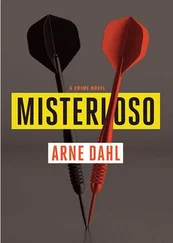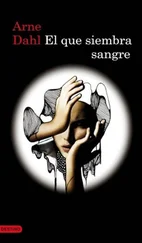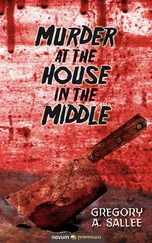The remarkable thing was that this didn’t happen. Not even in the last novel, The Terrorists , which was more or less completed by cutting and pasting it together after Wahlöö’s death. This novel is truly ideological down to the smallest detail. The final scene is significant. Martin Beck and his new lover, Rhea, are visiting the home of his former colleague Lennart Kollberg and his wife Gun. Here the entire series is supposed to be summed up, the threads from all ten books drawn together. There is also, in a rudimentary fashion, a political summation of the preceding ten years. But it happens in a relaxed and clear context. The four characters are sitting together playing a game as they chat. The game is called Crossword. One person says a letter of the alphabet and the others have to try to place it in a grid on their piece of paper. Kollberg keeps winning, and they keep starting over. He brings the scene to a close with the words: ‘It’s my turn to start. So I say “x,” “x” as in “Marx”.’
But the point is that the literary creation is never allowed to be subsumed by political proselytizing. The authors never forget the conventions of time and space; they never forget that the novel has to place the characters in a particular setting and that it has to be done with a certain vitality – a vitality that always comes before ideology. Which is what you will discover if you read the books closely.
With the sixth novel, Murder at the Savoy , from 1970, the ideological perspective moves to the forefront. From a purely literary point of view, the book is among the very best in the series – the technical skill of the authors is at its peak, and the humour is most fully developed – and yet the novel is also problematic. Both amazing and problematic.
It’s amazing because the literary creation has never been better. It’s problematic because the book personifies the least appealing side of the leftist politics of 1968. I think that in some ways we can talk about the dehumanizing side of the Left. The extremely predictable depiction of the capitalist circles criticized by the book is unrelenting. The corporate executive who is assassinated at the Savoy in Malmö in the opening chapter is given virtually no redeeming or even human qualities. Although there is a satirical power in the portrayal, it leaves the reader with a bitter aftertaste. So this was what the dehumanizing side of the Left looked like when ideology took precedence over humanism, and when the end was allowed to justify the means.
But if you’re prepared to accept this point of view, Murder at the Savoy makes for thoroughly fascinating reading. The book presents an incomparable picture of a social climate during a critical period in both Swedish and world history – a social climate that was in many ways idiotic and inhumane, and we are still living on the fringes of it today. If you read all ten books in order, you will actually discover that together they do form the story of a crime. An enormous crime.
What was it that Sjöwall and Wahlöö accomplished with their series of books? What was it that struck such a chord in a fifteen-year-old boy that twenty years later it triggered his own production of crime fiction? I think it was the sense of suppressed rage. A fire – but at the same time a strictly disciplined fire. The slowly emerging awareness that rage which is uncontrolled and without direction will fall flat. Yet at the same time, the fire must be present, and it must be preserved.
Maybe it was the desire to find a form for their anger.
Jan Arnald / Arne Dahl
(translated from the Swedish by Tiina Nunnally)
The day was hot and stifling, without a breath of air. There had been a haze quivering in the atmosphere, but now the sky was high and clear, its colours shifting from rose to dusky blue. The sun's red disc would soon disappear beyond the island of Ven. The evening breeze, which was already rippling the smooth mirror of the Sound, brought weak puffs of agreeable freshness to the streets of Malmö. With the gentle wind came fumes of the rotting refuse and seaweed that had been washed up on Ribersborg Beach and in through the mouth of the harbour into the canals.
The city doesn't resemble the rest of Sweden to a very great degree, largely because of its location. Malmö is closer to Rome than to the midnight sun, and the lights of the Danish coast twinkle along the horizon. And even if many winters are slushy and windblown, summers are just as often long and warm, filled with the song of the nightingale and scents from the lush vegetation of the expansive parks.
Which is exactly the way it was that fair summer evening early in July 1969. It was also quiet, calm and quite deserted. The tourists weren't noticeable to any extent – they hardly ever are. As for the roaming, unwashed hash-smokers, only the first bands had arrived, and not so many more would show up either, since most of them never get past Copenhagen.
It was rather quiet even in the big hotel across from the railway station near the harbour. A few foreign businessmen were deliberating over their reservations at the reception desk. The cloakroom attendant was reading one of the classics undisturbed in amongst the rails of coats. The dimly lit bar contained only a couple of regular customers speaking in low voices and a barman in a snow-white jacket.
In the large eighteenth-century dining room to the right of the lobby there wasn't much going on either, even if it was somewhat livelier. A few tables were occupied, mostly by people who were sitting alone. The pianist was taking a break. In front of the swinging doors leading to the kitchen stood a waiter, hands behind his back, looking contemplatively out of the big open windows, probably lost in thoughts of the sandy beaches not too far away.
A dinner party of seven, a well-dressed and solemn gathering of varying sexes and ages, was sitting in the back of the dining room. Their table was cluttered with glasses and fancy dishes, surrounded by champagne buckets. The restaurant personnel had discreetly withdrawn, for the host had just risen to speak.
He was a tall man in late middle age, with a dark-blue shantung suit, iron-grey hair and a deep suntan. He spoke calmly and skilfully, modulating his voice in subtly humorous phrases. The other six at the table sat watching him quietly; only one of them was smoking.
Through the open windows came the sounds of passing cars, trains switching tracks at the station across the canal, the largest junction in northern Europe, the abrupt hoarse tooting of a boat from Copenhagen, and somewhere on the bank of the canal a girl giggling.
This was the scene that soft warm Wednesday in July, at approximately eight-thirty in the evening. It's essential to use the expression ‘approximately’, for no one ever managed to pin down the exact time when it happened. On the other hand, what did happen is quite easy to describe.
A man came in through the main entrance, cast a glance at the reception desk with the foreign businessmen and the uniformed attendant, passed the cloakroom and the long narrow lobby outside the bar, and walked into the dining room calmly and resolutely, with steps that weren't notably rapid. There was nothing remarkable about this man so far. No one looked at him; he did not bother to look around either.
He passed the Hammond organ, the grand piano and the buffet with its array of glistening delicacies and continued past the two large pillars supporting the ceiling. With the same resolve he walked directly towards the party in the corner, where the host stood talking with his back turned to him. When the man was about five steps away, he thrust his right hand inside his suit coat. One of the women at the table looked at him, and the speaker half turned his head to see what was distracting her. He gave the approaching man a quick, indifferent glance, and started to turn back towards his guests, without a second's interruption in the comments he was making. At the same instant the newcomer pulled out a steel-blue object with a fluted butt and a long barrel, aimed carefully and shot the speaker in the head. The report was not shattering. It sounded more like the peaceful pop of a rifle in a shooting gallery at a fair.
Читать дальше












